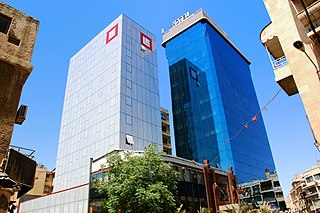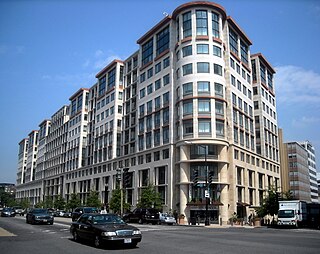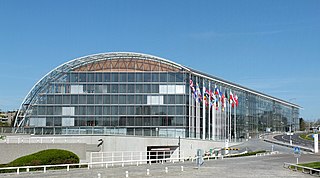Related Research Articles

The economy of Lebanon has been experiencing a large-scale multi-dimensional crisis since 2019, including a banking collapse, a liquidity crisis and a sovereign default. It is classified as a developing, lower-middle-income economy. The nominal GDP was estimated at $19 billion in 2020, with a per capita GDP amounting to $2,500. In 2018 government spending amounted to $15.9 billion, or 23% of GDP.

Syria's economic situation has been turbulent and their economy has deteriorated considerably since the beginning of the Syrian civil war, which erupted in March 2011.

The International Finance Corporation (IFC) is an international financial institution that offers investment, advisory, and asset-management services to encourage private-sector development in less developed countries. The IFC is a member of the World Bank Group and is headquartered in Washington, D.C. in the United States.
The International Development Association (IDA) is a development finance institution which offers concessional loans and grants to the world's poorest developing countries. The IDA is a member of the World Bank Group and is headquartered in Washington, D.C. in the United States. It was established in 1960 to complement the existing International Bank for Reconstruction and Development by lending to developing countries which suffer from the lowest gross national income, from troubled creditworthiness, or from the lowest per capita income. Together, the International Development Association and International Bank for Reconstruction and Development are collectively generally known as the World Bank, as they follow the same executive leadership and operate with the same staff.

The European Investment Bank (EIB) is the European Union's development bank and is owned by the EU Member States. It is one of the largest supranational lenders in the world. The EIB finances and invests both through equity and debt solutions projects that achieve the policy aims of the European Union through loans, guarantees and technical assistance.

The International Rescue Committee (IRC) is a global humanitarian aid, relief, and development nongovernmental organization. Founded in 1933 as the International Relief Association, at the request of Albert Einstein, and changing its name in 1942 after amalgamating with the similar Emergency Rescue Committee, the IRC provides emergency aid and long-term assistance to refugees and those displaced by war, persecution, or natural disaster. The IRC is currently working in about 40 countries and 26 U.S. cities where it resettles refugees and helps them become self-sufficient. It focuses mainly on health, education, economic wellbeing, power, and safety.

The Ugandan water supply and sanitation sector made substantial progress in urban areas from the mid-1990s until at least 2006, with substantial increases in coverage as well as in operational and commercial performance. Sector reforms from 1998 to 2003 included the commercialization and modernization of the National Water and Sewerage Corporation (NWSC) operating in cities and larger towns, as well as decentralization and private sector participation in small towns.
The OPEC Fund for International Development is an intergovernmental development finance institution established in 1976 by the member states of the Organization of the Petroleum Exporting Countries (OPEC). The OPEC Fund was conceived at the Conference of the Sovereigns and Heads of State of OPEC Member Countries, which was held in Algiers, Algeria, in March 1975. A Solemn Declaration of the Conference "reaffirmed the natural solidarity which unites OPEC countries with other developing countries in their struggle to overcome underdevelopment", and called for measures to strengthen cooperation between these countries.
Water supply and sanitation in Lebanon is characterized by a number of achievements and challenges. The achievements include the reconstruction of infrastructure after the 1975–90 Civil War and the 2006 war with Israel, as well as the reform of the water and sanitation sector through a water law passed in 2000. The law created four Regional Water Establishments to consolidate numerous smaller utilities.
Refugees of the Syrian Civil War are citizens and permanent residents of Syria who have fled the country throughout the Syrian Civil War. The pre-war population of the Syrian Arab Republic was estimated at 22 million (2017), including permanent residents. Of that number, the United Nations (UN) identified 13.5 million (2016) as displaced persons, requiring humanitarian assistance. Of these, since the start of the Syrian Civil War in 2011 more than six million (2016) were internally displaced, and around five million (2016) had crossed into other countries, seeking asylum or placed in Syrian refugee camps worldwide. It is often described as one of the largest refugee crises in history.
Qatar Charity is a humanitarian and development non-governmental organization in the Middle East. It was founded in 1992 in response to the thousands of children who were made orphans by the Afghanistan war and while orphans still remain a priority cause in the organization's work with more than 150,000 sponsored orphans, it has now expanded its fields of action to include six humanitarian fields and seven development fields.

The World Bank Group is a family of five international organizations that has provided leveraged loans and monetary assistance to the Central American country of Honduras in order to assist with the funding of critical tasks needed to ensure security of Honduran access to financing, expansion of social program coverage, and rural development. The country is the second poorest in Central America and its high poverty rate of 66% in 2016 has prompted an increased focus on the importance of diversification of rural income sources, quality education, and targeted social programs as a way of spurring economic growth.
The World Bank Group country partnership framework aims to support Haiti's efforts to reduce poverty and provide economic opportunities for all Haitians. The framework aims to strengthen institutions, government capacity, and public financial management as aid and concessional financing rapidly decline.

The World Bank Group (WBG) provides grants, credits and policy analysis to support economic development in Tanzania with a focus on infrastructure and private sector growth. As of 2018, WBG supports 25 active projects with funding of more than $3.95 billion. The WBG provides analytical and technical assistance in coordination with these projects. From 2007-2018 Tanzania maintained real GDP growth averaging 6.8% a year. Growth concentrated in the agricultural and transportation sectors. Complementing this growth, the poverty rate in Tanzania fell from 28.2% in 2012 to 26.9% in 2016. Debate exists over the validity of this growth as development may be unevenly dispersed among different geographic and income groups.

Since the onset of the Syrian Civil War in March 2011, over 1.5 million Syrian refugees have fled to Lebanon, and constitute nearly one-fourth of the Lebanese population today. Lebanon currently holds the largest refugee population per capita in the world.
The Bisri Dam is a planned dam on the Bisri river in Lebanon. The dam is part of the Lebanon Water Supply Augmentation project, with water management as the primary purpose. The project is organised by the Government of Lebanon in order to tackle the water problems in Lebanon and specifically in the Greater Beirut and the Mount Lebanon area. The expected funding for the project was coming from the World Bank, the Islamic Development Bank, and the Government of Lebanon, and it is executed by the Lebanese Council for Development and Reconstruction. The Bisri dam project started on September 30, 2014, and is projected to end by June 30, 2024. The dam is planned to be located 35 kilometres south of Beirut in Bisri Valley close to the village of Bisri. Due to its impact on the environment, archaeological sites, agriculture and its seismic risk the dam project is subject to opposition from civil society, political parties, adjacent municipalities and also internationally.
The Saudi Fund for Development (SFD) is a Saudi Arabian government agency that provides development assistance to developing countries by financing social and infrastructure projects. The fund seeks to support the economies of recipient countries by enhancing economic growth and promoting job opportunities. SFD was established in 1974 and began operations in 1975. SFD's activities include development, finance, trade, and funding. The fund is led by H.E. Mr. Ahmed bin Aqeel Al-khateeb who also serves as the Minister of Tourism for Saudi Arabia.

Jordan–Spain relations are the bilateral and diplomatic relations between these two countries. Jordan has an embassy in Madrid and two consulates in Barcelona and Bilbao. Spain has an embassy in Amman.
Tajikistan did not join in the World Bank until 1993. Before the collapse of USSR in 1991, Tajikistan was experiencing planned economy which was dominated by Moscow. Right after the dissolution, different from other nations which experienced a relatively stable transition from planned economy to market economy, Tajikistan fell into a serious civil war. As a result, the first mission after Tajikistan became the official member of the World Bank, was to recover its economy from bullets and blood. In 1997. $10 million credit was grant for Post-Conflict Rehabilitation Project. The proposed credit was used to conduct necessary imports and to restore production. Under different time periods, the World Bank and Tajikistan worked together in response to various problems. Later on, the economic crisis of 2008 caused the inflation of food prices in Tajikistan. In response to the crisis, the World Bank issued $6.25 million for the Emergency Food Security and Seed Imports Project in order to help at least 28000 households to release the food price pressure. Coming into the 21st century, Tajikistan received financing from IDA and IBRD of the World Bank with respect to programs of healthcare, education, irrigation and agriculture. Over the past years, Tajikistan has received over 130 projects of which 17 are active and a total of over $1.4 billion from the World Bank. With the help of those projects, from 2000 to 2017, the poverty rate in Tajikistan had been decreased from 83% to 29.5%. Besides, current GDP growth rate in Tajikistan is around 7%. Nevertheless, with a stable GDP growth rate, Tajikistan is still one of the poorest countries in Central Asia.
Sustainable Development Goals and Lebanon explains major contributions launched in Lebanon towards the advancement of the Sustainable Development Goals SDGs and the 2030 agenda.
References
- ↑ "All Projects". www.WorldBank.org. Retrieved 29 May 2017.
- ↑ "Lebanon Projects & Programs". www.WorldBank.org. Retrieved 29 May 2017.
- ↑ "Projects - Lending". web.WorldBank.org. Retrieved 3 June 2017.
- ↑ "Lebanon Overview". www.WorldBank.org. Retrieved 3 June 2017.
- ↑ World Bank Group (July 14, 2016). "Lebanon: Country Partnership Framework FY2017-FY2022" (PDF). World Bank Group's Country Partnership Framework.
- ↑ Bank, The World (2017-06-01). "Lebanon - Greater Beirut Water Supply Project : procurement plan".
{{cite journal}}: Cite journal requires|journal=(help) - ↑ Rafeh,Nadwa (24 May 2017). "Lebanon - Emergency Primary Healthcare Restoration Project : P152646 - Implementation Status Results Report : Sequence 05".
{{cite journal}}: Cite journal requires|journal=(help) - ↑ Sarraf,Maria (2017-05-22). "Lebanon - Lake Qaraoun Pollution Prevention Project : P147854 - Implementation Status Results Report : Sequence 02".
{{cite journal}}: Cite journal requires|journal=(help) - ↑ "Projects : Roads and Employment Project | The World Bank". projects.WorldBank.org. Retrieved 3 June 2017.
- ↑ "Projects : Reaching All Children with Education in Lebanon Support Project | The World Bank". projects.WorldBank.org. Retrieved 3 June 2017.
- ↑ "Projects : Additional Financing for Emergency National Poverty Targeting Program | The World Bank". projects.WorldBanks.org. Retrieved 3 June 2017.
- ↑ "Projects : Emergency Education System Stabilization | The World Bank". projects.WorldBank.org. Retrieved 3 June 2017.
- ↑ "Projects - All Country Loans/Credits/Grants". web.WorldBank.org. Retrieved 3 June 2017.
- 1 2 "Lebanon Overview". www.WorldBank.org. Retrieved 3 June 2017.
- ↑ "Objectives and Scope | Global Concessional Financing Facility". GlobalCFF.org. Retrieved 3 June 2017.